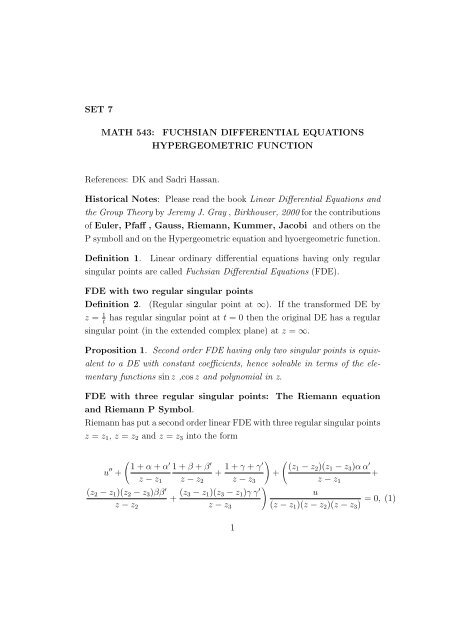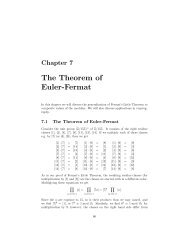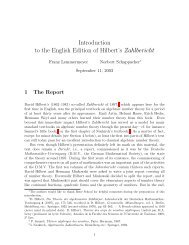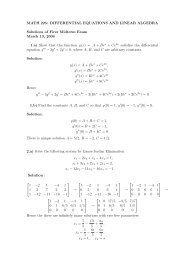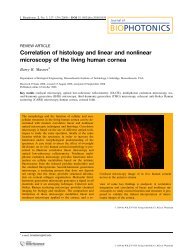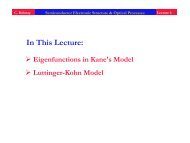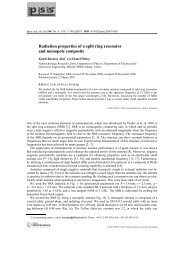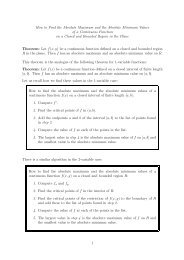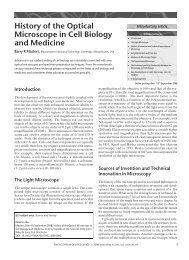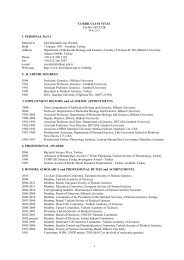SET 7 MATH 543: FUCHSIAN DIFFERENTIAL EQUATIONS ...
SET 7 MATH 543: FUCHSIAN DIFFERENTIAL EQUATIONS ...
SET 7 MATH 543: FUCHSIAN DIFFERENTIAL EQUATIONS ...
Create successful ePaper yourself
Turn your PDF publications into a flip-book with our unique Google optimized e-Paper software.
<strong>SET</strong> 7<br />
<strong>MATH</strong> <strong>543</strong>: <strong>FUCHSIAN</strong> <strong>DIFFERENTIAL</strong> <strong>EQUATIONS</strong><br />
HYPERGEOMETRIC FUNCTION<br />
References: DK and Sadri Hassan.<br />
Historical Notes: Please read the book Linear Differential Equations and<br />
the Group Theory by Jeremy J. Gray , Birkhouser, 2000 for the contributions<br />
of Euler, Pfaff , Gauss, Riemann, Kummer, Jacobi and others on the<br />
P symboll and on the Hypergeometric equation and hyoergeometric function.<br />
Definition 1. Linear ordinary differential equations having only regular<br />
singular points are called Fuchsian Differential Equations (FDE).<br />
FDE with two regular singular points<br />
Definition 2. (Regular singular point at ∞). If the transformed DE by<br />
z = 1<br />
t<br />
has regular singular point at t = 0 then the original DE has a regular<br />
singular point (in the extended complex plane) at z = ∞.<br />
Proposition 1. Second order FDE having only two singular points is equiv-<br />
alent to a DE with constant coefficients, hence solvable in terms of the ele-<br />
mentary functions sin z ,cos z and polynomial in z.<br />
FDE with three regular singular points: The Riemann equation<br />
and Riemann P Symbol.<br />
Riemann has put a second order linear FDE with three regular singular points<br />
z = z1, z = z2 and z = z3 into the form<br />
u ′′ <br />
′ 1 + α + α 1 + β + β<br />
+<br />
z − z1<br />
′<br />
+<br />
z − z2<br />
1 + γ + γ′<br />
<br />
(z1 − z2)(z1 − z3)α α<br />
+<br />
z − z3<br />
′<br />
+<br />
z − z1<br />
(z2 − z1)(z2 − z3)ββ ′<br />
+<br />
z − z2<br />
(z3 − z1)(z3 − z1)γ γ ′<br />
<br />
u<br />
= 0, (1)<br />
z − z3 (z − z1)(z − z2)(z − z3)<br />
1
where α, α ′ , β, β ′ , γ, γ ′ are constant satisfying the constraint<br />
α + α ′ + β + β ′ + γ + γ ′ = 1<br />
The solution of (1) is denoted as the Riemann P-symbol<br />
u(z) = P<br />
⎧<br />
⎪⎨<br />
⎪⎩<br />
z1 z2 z3<br />
α β γ z<br />
α ′ β ′ γ ′<br />
The columns in the P symbol indicate the location of the regular singular<br />
points and the corresponding roots of the indical equation, i.e.,<br />
1. z = z1, r1 = α and r2 = α ′ .<br />
2. z = z2, r1 = β and r2 = β ′ .<br />
3. z = z3, r1 = γ and r2 = γ ′ .<br />
One can reduce the 9 number of parameters in the Riemann equation (or in<br />
the Riemann P symbol) into three parameters by using the following type of<br />
transformation<br />
(i) u(z) = (z − z1) r (z − z2) s (z − z3) t v(z), r + s + t = 0<br />
(ii) The Mobius transformation: z ′ = (z−z1) (z3−z2)<br />
(z−z2) (z3−z1)<br />
we obtain first (from (i) above)<br />
P<br />
⎧<br />
⎪⎨<br />
⎪⎩<br />
z1 z2 z3<br />
α β γ z<br />
α ′ β ′ γ ′<br />
⎫<br />
⎪⎬<br />
and the using (ii) we obtain<br />
P<br />
⎧<br />
⎪⎨<br />
⎪⎩<br />
z1 z2 z3<br />
α β γ z<br />
α ′ β ′ γ ′<br />
<br />
z − z1<br />
α <br />
z − z3<br />
γ<br />
=<br />
P<br />
⎪⎭ z − z2 z − z2 ⎪⎩<br />
1 − c b c − a − b<br />
⎧<br />
⎪⎨<br />
⎫<br />
⎪⎬<br />
⎪⎭<br />
(2)<br />
z1 z2 z3<br />
0 a 0 z<br />
⎫<br />
⎧<br />
⎪⎬ <br />
z − z1<br />
α <br />
z − z3<br />
γ ⎪⎨<br />
0<br />
=<br />
P 0<br />
⎪⎭ z − z2 z − z2 ⎪⎩<br />
∞<br />
a<br />
1<br />
0 z ′<br />
1 − c b c − a − b<br />
⎫<br />
⎪⎬<br />
,<br />
⎪⎭<br />
(4)<br />
2<br />
(3)<br />
⎫<br />
⎪⎬<br />
⎪⎭
where<br />
z ′ = (z − z1)(z3 − z2)<br />
,<br />
(z − z2)(z3 − z1)<br />
a = α + β + γ, (5)<br />
b = α + β ′ + γ, c = 1 + α − α ′<br />
(6)<br />
The P symboll in the right hand side of (4) is the hypergeomtric function,<br />
F (a, b; c; z ′ )<br />
Problems<br />
F (a, b; c; z) = P<br />
⎧<br />
⎪⎨<br />
⎪⎩<br />
0 ∞ 1<br />
0 a 0 z<br />
1 − c b c − a − b<br />
1. Prove that the hypergeometric function defined above (7) satisfies the<br />
differential equation (hypergeometric DE)<br />
z(1 − z) u ′′ + [c − (1 + a + b) z) u ′ − ab u = 0 (8)<br />
2. Find (Kummer) transformations leaving the Reiemann equation form<br />
invariant.<br />
3. Prove that<br />
where<br />
an =<br />
F =<br />
Γ(a + n)<br />
, bn =<br />
Γ(a)<br />
4. Prove the following Proposition.<br />
∞<br />
n=0<br />
an bn<br />
cn<br />
z n<br />
n!<br />
Γ(b + n)<br />
, cn =<br />
Γ(b)<br />
Γ(c + n)<br />
Γ(c)<br />
⎫<br />
⎪⎬<br />
⎪⎭<br />
|z| ≤ 1<br />
Proposition 2. Solutions of the hypergeometric function bout its regular<br />
singular points z = 0, z = ∞ and z = 1, provided 1 − c, b − a, and c − a − b<br />
are not integers, are respectively given by<br />
3<br />
(7)
u(z) = A1 F (a, b; c; z) + B1 z 1−c F (b − c + 1, a − c + 1; 2 − c; z), (9)<br />
u(z) = A2 z −a F (a, a − c + 1; a − b + 1; 1<br />
z ) + B2 z −b<br />
F (b, b − c + 1; b − a + 1; 1<br />
),<br />
z<br />
(10)<br />
u(z) = A3 F (a, b; a + b + 1 − c; 1 − z) + B3 z c−a−b F (c − b, c − a;<br />
1 + c − a − b; 1 − z), (11)<br />
where Ai, Bi, (i = 1, 2, 3) are arbitrary constants.<br />
5. Find the solutions (10) and (11) about the regular singular points z = ∞<br />
and z = 1 by the use of Kummer’s transformations mentioned in the Pr.2.<br />
6. Prove the following: The Jacobi function P (α,β)<br />
λ<br />
equation equation<br />
satisfying the Jacobi<br />
(1 − z 2 )u ′′ + [β − α − (α + β + 2)z]u ′ + λ(λ + α + β + 1)u = 0<br />
can be written in terms of the hypergeometric function<br />
P (α,β)<br />
λ =<br />
Γ(n + α + 1)<br />
1 − z<br />
F (−λ, λ + α + β; α + 1;<br />
Γ(n + 1)Γ(α + 1) 2 )<br />
When λ = n a non-negative integer the the solution becomes Jacobi polyno-<br />
mials containing the Legendre, and Tchbechev polynomials.<br />
7. Prove that when the regular singular points z = z2 and z3 of the Rie-<br />
mann equation are pushed out ∞ then the resulting function function is the<br />
confluent hypergeometric function Φ(a, c; z) in<br />
8. Prove that Φ(a, c, z) = limb→∞ F (a, b; c; z<br />
b )<br />
9. Prove that the confluent hypergeometric function satisfies the DE<br />
z u ′′ + (c − z) u ′ − a u = 0 (12)<br />
10. Prove that the point z = ∞ of the confluent hypergeometric equation<br />
(12) is an irregular singular point.<br />
4
11. Find solutions of the confluent hypergeometric equation about all it<br />
regular singular points. The form of the equation is of the form<br />
u(z) = A Φ(a, c; z) + B z 1−c Φ(a ′ , c ′ , b ′ z)<br />
where A and B are arbitrary constants. Find the constants a ′ , c ′ and b ′<br />
12. Prove that Bessel’s function Jv(z) satisfying the Bessel equation u ′′ +<br />
1<br />
z u′ + (1 − ν2<br />
z 2 )u = 0 is given by<br />
13. Prove that<br />
d n<br />
Jv(z) =<br />
1<br />
Γ(ν + 1) (z/2)ν Φ(ν + 1/2, 2ν + 1; 2iz)<br />
Γ(a + n)Γ(b + n)Γ(c)<br />
F (a, b; , c; z) =<br />
dzn Γ(a)Γ(b)Γ(c + n)<br />
Use induction.<br />
14. Prove the following:<br />
(i) F (−a, b; b; −z) = (1 + z) a ,<br />
(ii) F (1, 1; 2; −z) = 1 ln(1 + z),<br />
z<br />
(iii) F ( 1<br />
2<br />
(iv)<br />
1 3 , ; 2 2 ; z2 ) = 1<br />
z sin−1 z,<br />
F ( 1 1<br />
,<br />
2 2 ; 1; z2 ) = 2<br />
π<br />
(v) e z = limb→∞ F ((1, b, 1, z<br />
b )<br />
(vi) The error function<br />
Erf(z) =<br />
π<br />
2<br />
0<br />
∞<br />
0<br />
F (a + n, b + n; c + n; z)<br />
dθ<br />
√ 1 − z 2 sin 2 θ ,<br />
e −t2<br />
dt<br />
15. Prove that the Hermite-Weber differential equation<br />
u ′′ + (ν + 1 1<br />
−<br />
2 4 z2 )u = 0<br />
can be converted to the confluent hypergeometric equation by<br />
with<br />
u(z) = e −z2<br />
4 v(ξ), ξ = z2<br />
2<br />
v(ξ) = Φ(−ν/2, 1/2; ξ)<br />
5


